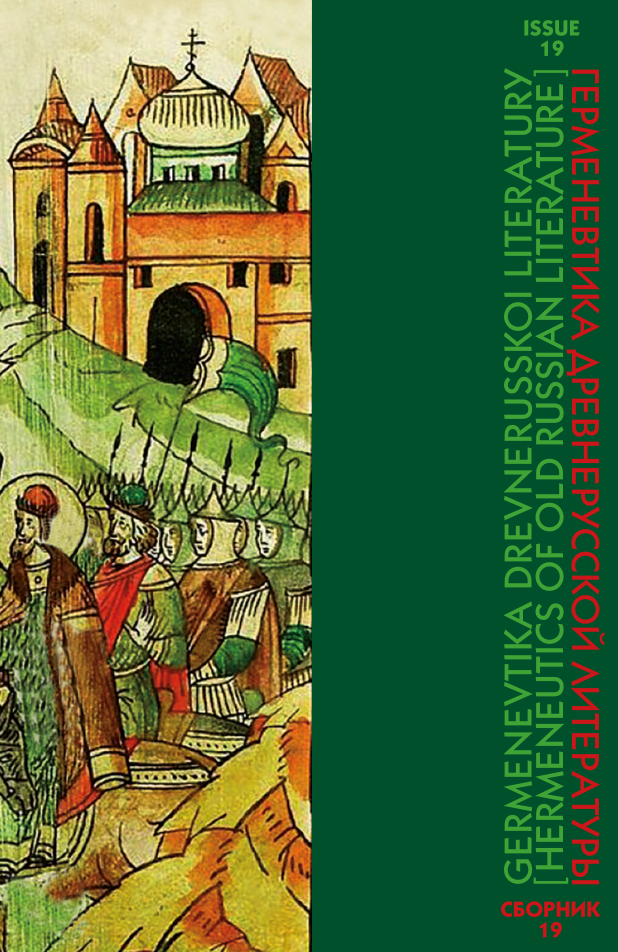Abstract:
The epistolary traditions of medieval Russia had the most varied sources. In this article, we address the problem of the Genesis of the formative models that formed the basis of the architectonics of the most famous Epistles of medieval Russia. The polemical Epistles of Ivan the Terrible, which have long been included in the circle of classical texts of medieval Russia, should be considered in the context of the development of the Epistle genre as such. But its General theory, as well as a complete history over the course of seven centuries of the development of East Slavic literature has not yet been created. This is due to the objective difficulties associated with the nature of this genre. In medieval Russia, the message is changeable. It not only stands between everyday life and high book tradition, but is also prone to frequent transformations. It is sometimes rhetorical, sometimes ordinary, but at the same time both rhetoric and uncomplicated style do not exclude publicism and public sound. Nevertheless, within the boundaries of the creativity of individual authors, the epistle has completely separated itself as a very peculiar type of source, endowed with such formal and meaningful features that allow it to be distinguished from works of other genres. Comparing the polemical letters of Ivan the Terrible with each other and some other texts of the same author, which are adjacent to them, allows us to talk about a single architectonics and General methods of suggestion — persuasion of the addressee for such letters. The main compositional units of Ivan IV’s letters echo the structure of late Byzantine epistolography. But this coincidence is only external. The basic set of motifs and formulas of Byzantine writing was strikingly different from the epistolary manner that Ivan IV developed. His polemical texts go back to the polemical treatise, diplomatic letters, and private writing.
References:
- Аntonova, M.V., and Nikishchenkova, G.V. “Formuliar drevnerusskogo poslaniia: Feodosii Pecherskii, ego sovremenniki i posledovateli” [“Form of Old Russian Epistle: Theodosius of Pechersk, his Contemporaries and Successors”]. Uchenye zapiski Orlovskogo gosudarstvennogo universiteta. Seriia: Gumanitarnye i sotsial’nye nauki, no. 3(1), 2010, pp. 154–161. (In Russian)
- Arutiunova, N.D. Iazyk i mir cheloveka [Language and the Human World]. Moscow, Iazyki russkoi kul’tury Publ., 1999. 895 p. (In Russian)
- Biblioteka literatury Drevnei Rusi [Library of Literature of Old Russia], vol. 11. St. Petersburg, Nauka Publ., 2001. 684 p. (In Russian)
- Bulanin, D.M. Perevody i poslaniia Maksima Greka. Neizdannye teksty [Translations and Epistles of Maximus the Greek. Unreleased Texts]. Leningrad, Nauka Publ., 1984. 278 p. (In Russian)
- Vereshhagin, E.M. Cerkovnoslavjanskaja knizhnost’ na Rusi. Lingvo-tekstolo- gicheskie razyskanija [Church Slavonic Literature in Russia. Linguo-Textual Research]. Moscow, Indrik Publ., 2001. 608 p. (In Russian)
- Vereshchagin, E.M., and Kostomarov, V.G. Iazyk i kul’tura [Language and Culture]. Moscow, Indrik Publ., 2005. 1040 p. (In Russian)
- Kalugin, V.V. Andrei Kurbskii i Ivan Groznyi (Teoreticheskie vzgliady I literaturnaia tekhnika drevnerusskogo pisatelia) [Andrey Kurbsky and Ivan the Terrible (Theoretical Views and Literary Technique of the Old Russian Writer)]. Moscow, Iazyki russkoi kul’tury Publ., 1998. 416 p. (In Russian)
- Kolesov, V.V. Drevnerusskii literaturnyi iazyk [Old Russian Literary Language]. Leningrad, Izdatel’stvo Leningradskogo universiteta Publ., 1984. 296 p. (In Russian)
- Koniavskaia, E.L. Avtorskoe samosoznanie drevnerusskogo knizhnika (XI–XV vv.) [Author’s Self-Consciousness of the Old Russian Scribe (11th–15th Centuries)]. Moscow, Iazyki russkoi kul’tury Publ., 2000. 199 p. (In Russian)
- Morozov, B.N. “Osobaia redaktsiia Pervogo poslaniia Kurbskogo Ivanu Groznomu” [“Special Edition of Kurbsky’s First Epistle to Ivan the Terrible”]. Arkhiv russkoi istorii [Archive of Russian History], issue 5. Moscow, Arkheograficheskii tsentr Publ., 1994, pp. 145–151. (In Russian)
- Ponyrko, N.V. Epistoliarnoe nasledie Drevnei Rusi. XI–XIII vv. Issledovaniia, teksty, perevody [Epistolary Heritage of Old Russia. 11th–13th Centuries. Research, Texts, Translations]. St. Petersburg, Nauka Publ., 1992. 217 p. (In Russian)
- Popova, O.V. Iazykovaia lichnost’ Ivana Groznogo (na materiale delovykh poslanii) [Language Personality of Ivan the Terrible (Based on Business Letters): PhD thesis, summary]. Omsk, 2004. 177 p. (In Russian)
- Poslaniia Ivana Groznogo [Letters of Ivan The Terrible]. Moscow, Leningrad, Izdatel’stvo AN SSSR Publ., 1951. 716 p. (In Russian)
- Smetanin, V.A. “Epistolologiia pozdnei Vizantii, proelevsis. (Konkretno istoricheskaia chast’)” [“Epistemologia of Late Byzantium, Proelefsis. (Specifically, the Historical Part)”]. Antichnaia drevnost’ i srednie veka [Ancient and middle ages], vol. 15. Sverdlovsk, Ural’skii gosudarstvennyi universitet Publ., 1978, pp. 60–82. (In Russian)
- Filiushkin, A.I. “Logika spora Ivana Groznogo s Andreem Kurbskim” [“Logic оf Ivan the Terrible’s Dispute with Andrey Kurbsky”]. Germenevtika drevnerusskoi literatury [Hermeneutics of Old Russian Literature], issue 9. Moscow, Nasledie Publ., 1998, pp. 236–263. (In Russian)
- Shmidt, S.O. “K istorii perepiski Kurbskogo i Ivana Groznogo” [“To the History of Correspondence between Kurbsky and Ivan the Terrible”]. Kul’turnoe nasledie Drevnei Rusi (Istoki, Stanovlenie. Traditsii) [Cultural heritage of Ancient Russia (Origins, Formation. Traditions)]. Moscow, Nauka Publ., 1976, pp. 147–151. (In Russian)






